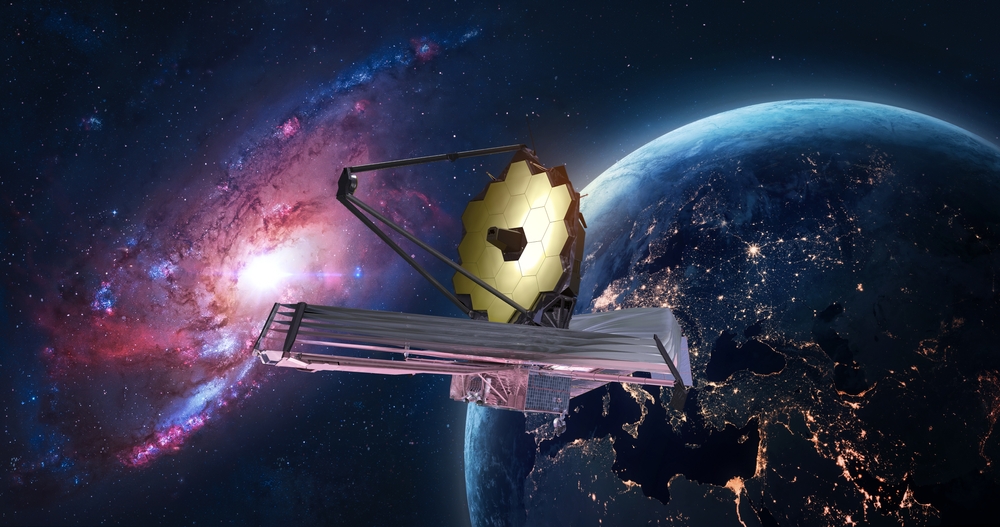James Webb Officially Detected a Molecule Called Dimethyl Sulfide on an Alien World. On Earth, This Molecule Is Only Produced by Living Organisms.

What if the answer to one of humanity’s oldest questions—“Are we alone in the universe?”—is closer than we think? Imagine a world far away, 120 light-years from Earth, where something incredible has just been discovered. Something that could change everything we know about life in the cosmos.
NASA’s James Webb Space Telescope, the most advanced space observatory ever created, has made a tantalizing detection on an exoplanet named K2-18 b. Deep in its atmosphere, researchers believe they’ve found a molecule called dimethyl sulfide (DMS). On Earth, this molecule is only produced by living organisms—specifically, phytoplankton in the oceans. Its detection on this distant world is a potential sign that life might exist beyond our planet.
But here’s the catch: scientists are cautious. While the discovery is exciting, it’s not conclusive. The evidence is still tentative, and more data is needed. Yet, the possibility that life—or at least the building blocks of life—exists on another world is too compelling to ignore. This discovery isn’t just another step in space exploration. It could be a glimpse into the answer to one of the most profound questions humanity has ever asked.
Are we alone? The search for that answer has just taken a bold new turn.
The Molecule That Could Change Everything: What Is Dimethyl Sulfide?

Dimethyl sulfide (DMS) might sound like just another scientific term, but its potential to change our understanding of life beyond Earth is immense. On Earth, DMS is a molecule that we know well—it’s produced by life, specifically by marine phytoplankton. These tiny organisms, drifting in the ocean’s depths, release DMS as a byproduct of their metabolic processes. In fact, the largest source of DMS in Earth’s atmosphere comes from these ocean-dwelling microorganisms. But here’s the catch: DMS, as we understand it, is a molecule only produced by life.
So, when the James Webb Space Telescope detected traces of DMS in the atmosphere of K2-18 b, the excitement was palpable. This distant exoplanet, a world far beyond the reaches of our solar system, might just be showing signs that life—something resembling life as we know it—could exist elsewhere in the universe.
DMS is an ideal candidate for what scientists call a biosignature. In simple terms, a biosignature is a substance or molecule that can indicate the presence of life. Whether on Earth or elsewhere, certain molecules are unmistakably linked to biological processes. DMS is one of those molecules, and its presence on an exoplanet is not something astronomers take lightly. It suggests that K2-18 b might harbor conditions suitable for life—or at least, the potential for life to have once existed there.

Now, let’s be clear: this doesn’t mean we’ve found definitive proof of life. We’re still in the early stages of understanding what’s really happening on K2-18 b. But the idea that a molecule tied so closely to life on Earth could exist on a faraway planet is something worth paying attention to. It raises a question that, until recently, seemed almost impossible to answer: Could life exist on other worlds?
The detection of DMS on K2-18 b isn’t just a scientific breakthrough; it’s a reminder of how little we truly know about the universe—and how much more there is to discover.
The James Webb Space Telescope: A Leap Forward for Humanity
The James Webb Space Telescope (JWST) is not just another instrument in the vast expanse of space exploration—it’s a revolutionary tool that brings us closer to understanding the universe in ways that were once unimaginable. Unlike any telescope before it, JWST allows us to peer deeper into space with unprecedented clarity. With its advanced infrared capabilities, JWST can observe the faintest light from distant stars and planets, unlocking secrets about their atmospheres, compositions, and even potential for life.
K2-18 b, an exoplanet located 120 light-years away, has now become one of the prime examples of what JWST can accomplish. Though the distance between us and this faraway world is staggering, the data collected by JWST has given scientists a clearer picture of its atmosphere than ever before. This exoplanet’s star emits light that passes through its atmosphere, allowing the telescope to analyze it, much like reading a book by its cover. Through this method, JWST revealed a wealth of information: methane, carbon dioxide, and the intriguing molecule dimethyl sulfide (DMS).

This is a monumental leap in space exploration. What makes JWST’s findings stand out is its precision. A single observation of K2-18 b was as informative as eight separate observations made by the Hubble Space Telescope. This capability to gather in-depth data with fewer observations is just one of the many ways JWST is setting new standards for the exploration of distant worlds.
The discovery of DMS on K2-18 b is not just a victory for the scientific community—it’s a glimpse into humanity’s growing ability to uncover the mysteries of the cosmos. Each new finding, each new piece of data, brings us closer to understanding the fundamental question: Could there be life beyond Earth?
With JWST, we are not only looking at distant stars; we are looking at the very future of space exploration. This is a new frontier, and with it, new possibilities await. As we continue to study the exoplanets that JWST uncovers, we are one step closer to answering questions that have puzzled humanity for centuries.
K2-18 b: The Exoplanet with Potential

K2-18 b is not just another exoplanet. It’s a world that challenges our current understanding of what it takes to support life. Located in the “habitable zone” of its star—a region where conditions might allow liquid water to exist on the surface—K2-18 b offers a unique glimpse into a type of planet we don’t have in our own solar system. Nearly nine times the size of Earth, it’s classified as a sub-Neptune, a type of planet that lies between the size of Earth and Neptune. These planets are unlike anything we are familiar with, and their atmospheres remain a topic of active study.
What makes K2-18 b so intriguing is the possibility that it could be a Hycean world. Hycean planets are thought to have hydrogen-rich atmospheres and oceans of water beneath their clouds—environments that, at least in theory, could harbor life. In fact, K2-18 b seems to meet many of the criteria that scientists believe are essential for supporting life, including water and a relatively temperate climate. These worlds are becoming increasingly important in the search for life beyond Earth, as they may offer more favorable conditions for life than smaller, rocky planets traditionally thought to be the best candidates.
But here’s the catch: just because a planet has the potential to support life doesn’t mean it does. While K2-18 b seems to meet many of the prerequisites, we can’t say for certain that it hosts life—or ever did. The temperature of its ocean could be too extreme, and its atmosphere might not be as hospitable as we hope. But the discovery of molecules like methane and carbon dioxide—key ingredients for life as we know it—gives us more reason to be optimistic about the possibility that life might once have flourished, or perhaps still does, on this distant world.
What we are learning about K2-18 b isn’t just about this one planet; it’s about the broader universe of Hycean worlds that we have yet to fully explore. The discovery of these planets opens up an entirely new avenue in our search for life. For the first time, we are not just searching for Earth-like planets but are considering a wider range of environments where life might be hiding, waiting to be discovered.
K2-18 b is not the only world out there with the potential to harbor life, but it may be one of the most promising. As we gather more data and continue our search, this distant exoplanet stands as a testament to the infinite possibilities that lie beyond our own planet. And with each new discovery, we come one step closer to understanding the true nature of life in the cosmos.
Why We Must Be Careful with Bold Claims

As exhilarating as the discovery of dimethyl sulfide (DMS) on K2-18 b is, it’s important to remember that this finding isn’t the final word in the search for extraterrestrial life. The detection of DMS—while incredibly exciting—requires further scrutiny. Science is a method of continuous questioning, and with a discovery as monumental as this, we must exercise caution before making sweeping claims about life on other planets.
Prof. Nikku Madhusudhan, the lead researcher behind this discovery, has made it clear that while the evidence for DMS is intriguing, it is still tentative. “If confirmed, it would be a huge deal,” he stated, acknowledging the weight of such a claim. But the data gathered so far is not definitive. Scientists are calling for further observations, and in the world of astronomy, one discovery is often just the beginning of a longer journey toward truth.
This is a crucial point to understand. The detection of DMS on K2-18 b is groundbreaking, but it is not irrefutable proof of life. The molecule might be there, but its presence could have other explanations. The atmosphere of K2-18 b is rich in gases like methane and carbon dioxide, and while these are vital ingredients for life, they are also commonly found in non-living processes. The presence of these molecules alone doesn’t necessarily confirm biological activity; it simply suggests that the planet might harbor conditions that could support life.
It’s also worth recalling past scientific claims that were later disproven or refined. For instance, in 2020, astronomers made a bold claim about the detection of phosphine in Venus’s atmosphere, suggesting the possibility of microbial life. However, that claim was met with skepticism, and subsequent studies cast doubt on its validity. These kinds of experiences remind us why we must be careful with such extraordinary claims. In science, no discovery is ever final until it has been repeatedly tested, validated, and confirmed through independent means.
The scientific process isn’t just about uncovering exciting new findings; it’s about asking the hard questions, testing assumptions, and being open to the idea that what we think we know might not always be the full story. The search for life beyond Earth is complex, and each new piece of evidence is just a part of a much larger puzzle. The detection of DMS on K2-18 b might be the first step in a long and thrilling journey, but it’s just that—a step.
So, while the possibility of life on K2-18 b is tantalizing, it’s essential to remember that science is always evolving. We must embrace the uncertainty, the questions, and the need for further research. Because only through rigorous validation can we ensure that the story we’re telling about life in the universe is as accurate as it is inspiring.
The Quest Continues

The discovery of dimethyl sulfide on K2-18 b is a turning point in the search for life beyond Earth. While we don’t yet have the definitive proof, the fact that something as uniquely tied to life as DMS has been detected on a distant planet is enough to stir our imagination. It makes us wonder: Could we be closer than ever to finding life beyond our world? This discovery reminds us that the universe is vast, and there’s so much more waiting to be uncovered. Each new finding brings us closer to understanding our place in it.
But this quest isn’t just about uncovering the secrets of distant planets; it’s about asking bigger questions about our own existence. What does it mean to be human in a universe filled with so many possibilities? The search for life challenges us to expand our minds, to think beyond our immediate surroundings, and to connect with the larger story of the cosmos. It’s about realizing that we are not isolated—we are part of something much greater, something that’s constantly evolving and full of potential.
As we continue this journey, we must remember that discoveries like these are not just for scientists—they’re for all of us. They invite us to wonder, to dream, and to believe that anything is possible. The search for life beyond Earth is a reminder that we are all explorers at heart. And with every step forward, we come closer to answering one of humanity’s most enduring questions: Are we alone?
Featured Image Source: Shutterstock
Loading...
Related Content
 When Science Shows Our Bones Can Rise Again
When Science Shows Our Bones Can Rise AgainBy Prince Ea





